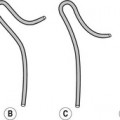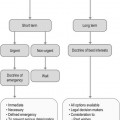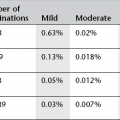Thyroid and parathyroids
Methods of imaging the thyroid and parathyroid glands
1. Plain film (limited to crude assessment of superior mediastinal extension of thyroid goitre and any secondary tracheal displacement and narrowing)
2. Ultrasound (US)
3. Computed tomography (CT)
4. Magnetic resonance imaging (MRI)
5. Radionuclide imaging, including positron emission tomography (PET).
Ultrasound of thyroid
Equipment
High-frequency transducer – minimum 10 MHz (though in larger patients and assessment of larger goitres lower-frequency probe may be needed). Linear array for optimum imaging.
Technique
The patient is supine with the neck extended. Longitudinal and transverse scans are taken of both lobes of the thyroid and the isthmus. Nodules are assessed for echogenicity, margins and architecture. If there is retrosternal extension, angling downwards and scanning during swallowing may enable the lowest extent of the thyroid to be visualized. Cervical lymph nodes should be routinely assessed at the same time.
Fine-needle aspiration (FNA) is a frequent adjunct to ultrasound examination; US characterization of nodules is limited and ideally US should be undertaken with the facility to proceed to FNA where there is concern about the US appearance.
Ultrasound of parathyroid
Normal parathyroid glands cannot be visualized by US because of their small size and similar texture to surrounding adipose tissue. US is performed using a similar technique to thyroid for the detection of parathyroid enlargement by adenomas, hyperplasia and carcinoma. Scanning whilst the patient’s head is turned can reveal deeper glands. Scanning for ectopic glands should include the neck below the thyroid down to the superior mediastinum, superiorly to the hyoid region and laterally to the carotid sheaths.
Gharib, H, Papini, E, Paschke, R, et al. American Association of Clinical Endocrinologists, Associazione Medici Endocrinologi, and European Thyroid Association medical guidelines for clinical practice for the diagnosis and management of thyroid nodules. Endocrine Practice. 2010; 16(Suppl 1):1–43.
Johnson, NA, Tublin, ME, Ogilvie, JB. Parathyroid imaging: technique and role in the preoperative evaluation of primary hyperparathyroidism. Am J Roentgenol. 2007; 188(6):1706–1715.
CT and MRI of thyroid and parathyroid
Indications
1. In staging of known thyroid malignancy
2. To assess extension of substernal goitre and tracheal compromise.
As a result of its iodine content, normal thyroid is hyperdense relative to adjacent soft-tissues on non-contrast-enhanced CT. Other than for staging medullary thyroid cancer, CT of the thyroid is routinely performed without intravenous (i.v.) contrast which interferes with subsequent radionuclide thyroid imaging or treatment. Particular care must be taken if iodinated i.v. contrast is administered to hyperthyroid patients (see Chapter 2). For MRI, gadolinium-based i.v. contrast agents can be used without compromise.
In parathyroid disease, contrast-enhanced CT and MRI are used:
Gharib, H, Papini, E, Paschke, R, et al. American Association of Clinical Endocrinologists, Associazione Medici Endocrinologi, and European Thyroid Association medical guidelines for clinical practice for the diagnosis and management of thyroid nodules. Endocrine Practice. 2010; 16(Suppl 1):1–43.
Johnson, NA, Tublin, ME, Ogilvie, JB. Parathyroid imaging: technique and role in the preoperative evaluation of primary hyperparathyroidism. Am J Roentgenol. 2007; 188(6):1706–1715.
Radionuclide thyroid imaging
Stay updated, free articles. Join our Telegram channel

Full access? Get Clinical Tree






